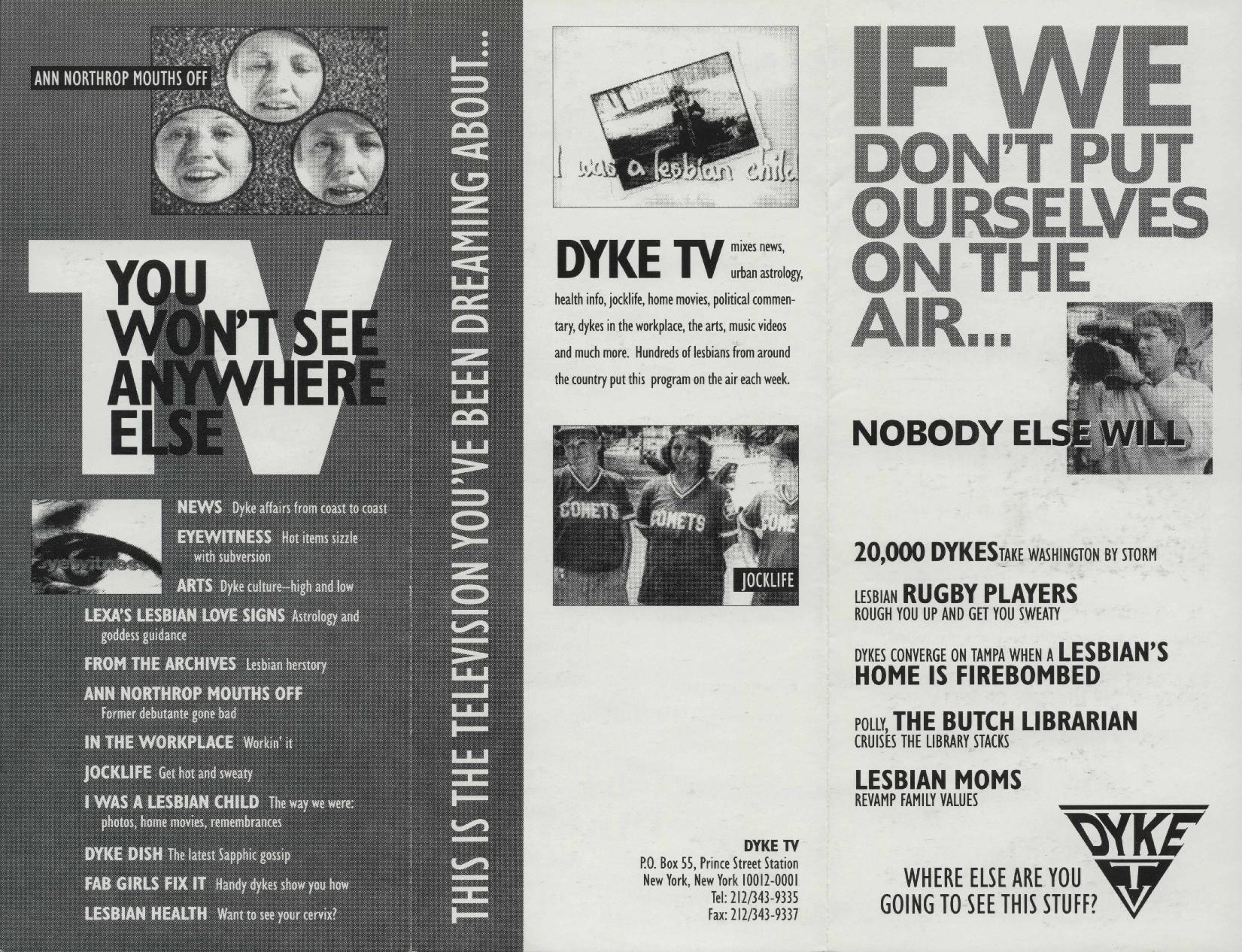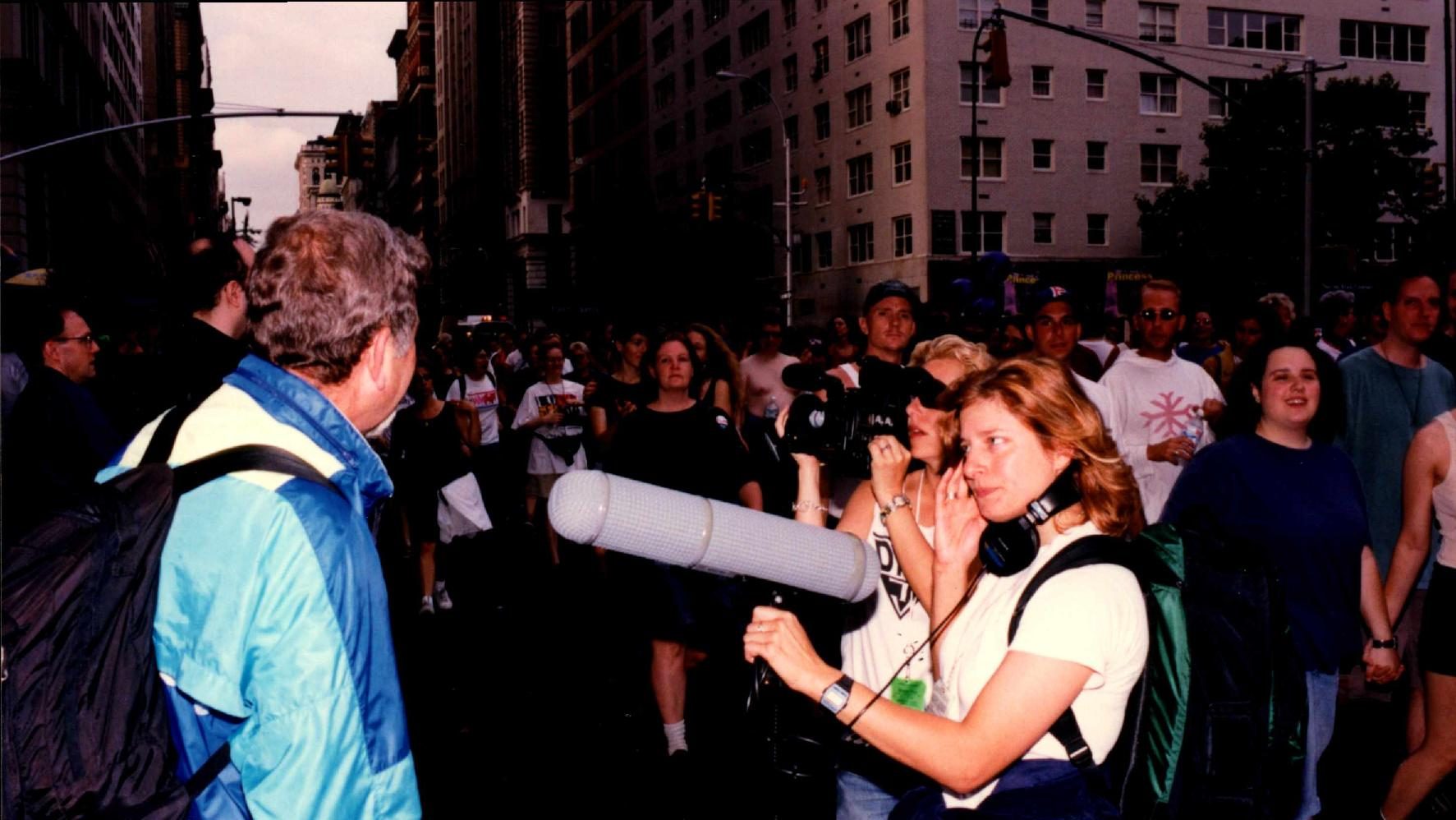Because If We Don’t Put Ourselves On The Air, Nobody Else Will
Public space is not given. It’s always a battle. The project of Dyke TV is evidence of the ongoing struggle lesbians face to be seen as legitimate political actors with voices worth listening to in the public arena.
Founded in December 1992, Dyke TV was both a reaction to the gross misrepresentation of lesbians in the mainstream press and a continuation of the lesbian community’s AIDS-era activism. Its programming was totally ad-free and grassroots, pulling about 80% of its funds from community grants and the other 20% directly from viewers,1 allowing Dyke TV producers the independence to create television to “incite, provoke, subvert, and organize” just how they wanted.

1993 March on Washington
On April 24th, 1993, the Lesbian Avengers organized the first ever Dyke March in Washington, DC. Just one day before the March on Washington for Lesbian, Gay, and Bi Equal Rights and Liberation, some 20,000 lesbians mobilized in protest of the overwhelmingly white, male focus of Gay Liberation movement.2 In this clip from the march, aired on the first ever episode of Dyke TV, members of the Lesbian Avengers can be heard chanting, “We’re dykes! We’re out! We’re out for power!”3
Dyke TV drew on the media-savvy strategies of organizations like ACT UP and the Lesbian Avengers to build a program that was provocative and progressive. Indeed, Dyke TV cofounder Mary Patierno often joked that Dyke TV was the “propaganda wing” of the Lesbian Avengers.4 Starting with the name — a controversial choice — Dyke TV created programming that was unapologetic and openly political. In one episode, host Ann Northrop would challenge viewers to stand up to the religious right, while in another, cast members would demonstrate how to perform a vaginal exam at home.
Distribution and Coalition Building
Out of its New York studio, Dyke TV held regular workshops to teach members of the community how to create their own media for the show.5 Whatever the segment was, so long as there was no profanity, Dyke TV would air it. The work of “stringers,” video producers who created content for Dyke TV but did not operate out of New York, was crucial, especially as Dyke TV expanded its coverage to include national and global stories.6 Their workshops also trained volunteers to edit segments and, crucially, to create dubs of video tapes to send around the country.
In 1995, Dyke TV began to be broadcast through Free Speech TV,7 a progressive satellite distribution company, and in 2001, it reached Canada through the PrideVision network.8 Over the 12 years Dyke TV was on air, it reached millions of households.9 Slowly but surely, Dyke TV built its viewership and global network, creating a coalition of lesbians and allies united in solidarity.
Much like the Dyke March, Dyke TV provided viewers with what Elizabeth Currans calls a “potent combination of pride and protest,” something that can connect while it disrupts. By making lesbian communities visible, through public demonstrations and media presence, by giving lesbians the tools to create media that felt meaningful to them, Dyke TV provided a model for how to “claim and hold space” for the “diverse needs within and beyond dyke communities.”10
Footnotes:
- “Dyke TV Facts Sheet,” n.d., Dyke TV Records, Box 73, Sophia Smith Collection, Northampton, Massachusetts. ↩
- Elizabeth Currans, “Enacting Spiritual Connection and Performing Deviance,” in Marching Dykes, Liberated Sluts, and Concerned Mothers: Women Transforming Public Space, (Chicago: University of Illinois Press, 2017), pp. 41 – 57, https://www.jstor.org/stable/10.5406/j.ctt1w6tds2. ↩
- Dyke TV, Episode 1, 1993, Dyke TV Records, Sophia Smith Collection, Northampton, Massachusetts. ↩
- “Mary Patierno, Mary Patierno Interview Transcript,” Nov. 26, 2016, Lesbian Herstory Archives AudioVisual Collection, Dyke TV, Lesbian Herstory Archives, New York, New York, http://herstories.prattinfoschool.nyc/omeka/exhibits/show/dyke-tv/item/843. ↩
- Ibid. ↩
- “Dyke TV Facts Sheet.” ↩
- “Free Speech TV Contract,” 1995, Box 76, Folder: Free Speech TV, Dyke TV Records, Sophia Smith Collection, Northampton, Massachusetts. ↩
- “Pride Vision Network,” 2001, Box 76, Folder: PrideVision, Dyke TV Records, Sophia Smith Collection, Northampton, Massachusetts. ↩
- Patierno, “Mary Patierno Interview,” 2016. ↩
- Currans, “Enacting Spiritual Connection,” 59. ↩
